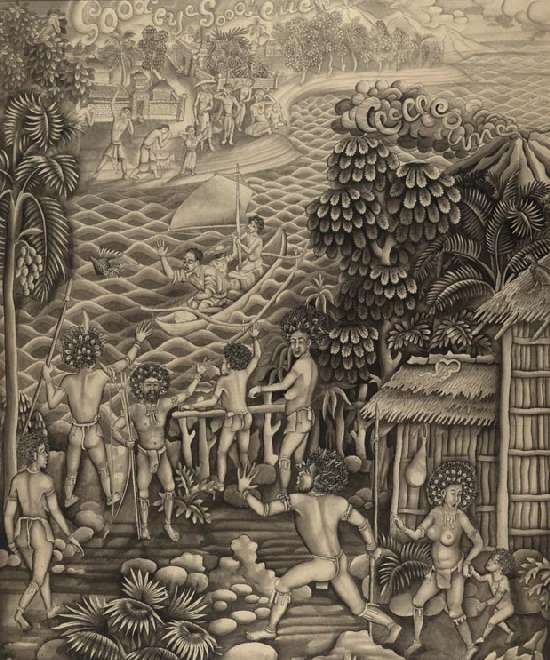Batuan Style Painting
An example of modern Balinese painting, still carring some traditional features. |
Batuan Style Painting
An example of modern Balinese painting, still carring some traditional features. |
Another kind of development in painting began to appear during the 1930s in the village of Batuan in Gianyar, south Bali. Unlike Ubud to the north, Batuan was an ancient court center which dated at least from the 11th century. With this strong historical and cultural foundation, artists in this area remained relatively free of Western aesthetic influences. They developed a very different style from that of Ubud, which has been relatively open to change in the arts since the late 1920s. Although several of the artists in Batuan had contact with the Pitamaha artists association through its branch in the village, their paintings at the time generally did not reflect much outside influence. On recently, since the 1980s, has this been the case.
Anthropologists Margaret Mead (American, 1901-1978) and Gregory Bateson (British, 1904-1980), doing research in this area from 1936-1938 and 1939, had little impact on the arts. However, they did provide art supplies to see what the painters would create in response to the increasing social-cultural changes and tensions in Bali. Some paintings also were commissioned by them for comparison. Works done mostly with black ink on paper from this early period reflected the artists concerns with magic, power, and ritual. Other themes came from Indian epic literature and indigenous Balinese-Javanese folk tales, along with religion and dance.
In spite of recent developments in response to tourism and the changes in aesthetic taste, Batuan Style works today still retain some unique identifying features dating from the 1930s. They usually have an expressive and vibrant vitality with detailed features and fine lines. Like traditional wayang (puppet) painting, multiple scenes in a single work retain the narrative element. Small, stylized figures fill the spaces, and Western-style anatomy was not a major concern until recently.
In most cases, little use is made of depth because light and shadow to any degree tend to be rather uniform throughout. As a result, Batuan style paintings appear somewhat dark and mysterious. This feeling is further reinforced by themes of black magic and intense rituals set amidst lush, decorative foliage in which supernatural beings and other creatures lurk. Muted colors on dark backgrounds create a mysterious and somber appearance, sometimes to the point of being rather terrifying and frightening.
While the themes used in these paintings are taken from literary sources, legends, folk tales, and daily life, they all tend to have elements of the supernatural. Watercolor or tempera on paper are preferred, although large works with acrylics on canvas also caricature visitors and show the Balinese having humorous encounters with them. These works of historical events are like pictorial journalism as seen by the artists of Batuan.
Suteja Neka
|
When Mead and Bateson departed for New Guinea, their Balinese secretary I Made Kaler commissioned a painting from one of Bali's most notable painters to commemorate the occasion. The painting shows Mead and Bateson leaving Bali and heading for New Guinea on a boat. The Balinese are on one shore and the Papua New Guineans on the other, with Mead and Bateson in the center. At the top, the Balinese volcano spells out "goodbye" and "good luck." Below and to the right, the New Guinea volcano says "welcome." |

|